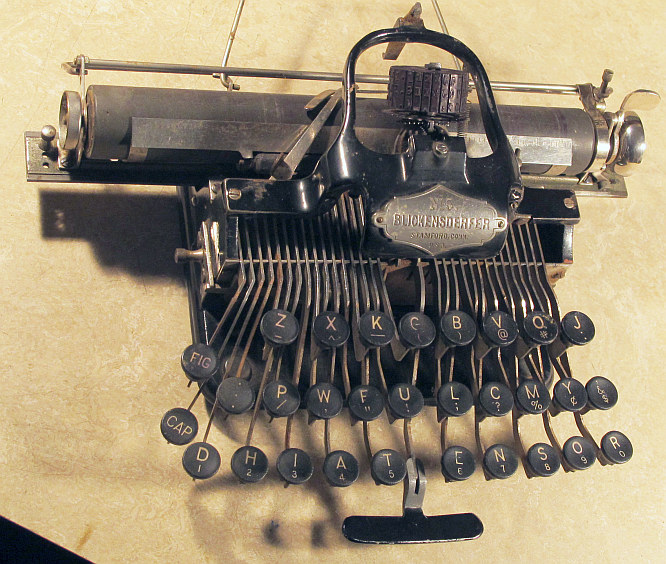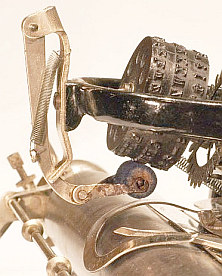previous <<==>> next
************************************************************************** < 1900 PORTABLE TYPEWRITERS P I C T U R E G A L L E R Y ************************************************************************** |
|
BLICKENSDERFER » NO.5 « Sorry, it came with MISSING INKER UNIT ...  ... After RESTORATION all works well - Except Inking ... SN = 26513 BLICKENSDERFER (1896) Stamford, Connecticut / USA BLICK (DHIATENSOR) Keyboard 8 cpi; 60 cpl 3(!) char/key INKER W * D * H = 12" * 9" * 5" 30.5 cm * 23 cm * 13 cm 6_1/3 lbs ; 2.9 kg ( w/o wood case ) Remarkable: Interchangeable Font Cylinders Found A Good Picture of the INKER UNIT and cropped a DETAIL ...  Lucky I am ... - "1000 Thanks!" - I got the missing INKER UNIT from RICHARD POLT Have a look at his "Classical Typewriter Page" ... To make it work, I had to replace the INKER FELT ...  (*) (*) |
(*) R E M A R K : "How to get a new FOAM-INK-ROLLER for the BLICK ???
============================================================================
There are CYLINDRICAL INK ROLLERS available for PRINTING ADDING MACHINES.
Eg. »R874-IRB« from GENERAL RIBBON CORP. for CANON, CASIO, ... TEXAS INSTR.
I destroyed the carrier and cut a 10 mm piece of the I N K E D F O A M
for my BLICK-5. Leftovers I sealed in a plastic bag for further usage.
Back to the Typewriter Overview
H I S T O R I C A L R E M A R K S found in WIKIPEDIA ...
****************************************************************************
http://en.wikipedia.org/wiki/Blickensderfer_typewriter
The Blickensderfer Typewriter was designed by George Canfield Blickensderfer
(1850–1917) in 1892. It was originally intended to compete with Remington
desk typewriters, but ended up being known for its portability.
Instead of the common mechanism with letters on the end of individual bars
connected to the keys, the Blickensderfer used a cylindrical wheel with
letters embossed on it. Pressing a key caused the cylinder to turn so the
correct letter was positioned over the paper, and continuing caused it to
be inked by a roller as it moved to press down on the paper. The mechanism
is very similar to the IBM Selectric design introduced decades later, with
the only major change being the shape of the striker. Like the Selectric,
one could easily change the typeface on a Blickensderfer simply by changing
the type cylinder.
The Blickensderfer system dramatically reduced complexity of the design. A
typical example contained only 250 parts, compared to the 2,500 parts of a
standard typewriter. It was much smaller, lighter, and cheaper than other
typewriters. The first known aluminum typewriter (marketed as the Blickens-
derfer 6 or the "Featherweight Blick") was made by Blickensderfer, as was
the first electric typewriter.
Early Blickensderfers were also notable for their keyboard layout. The home
row of keys contained the most commonly used letters, DHIATENSOR, allowing
the keyboardist keep their hands on the home row as much as possible, mini-
mizing extraneous hand movement and increasing efficiency. The QWERTY key-
board was originally designed to prevent the typebars on the Sholes &
Glidden from jamming. Since the Blickensderfer used the letter wheel, the
"scientific" keyboard layout could be used for maximum typing efficiency.
The first widely successful production model was the Blickensderfer »5«,
introduced at the 1893 World's Columbian Exposition. Production of the »5«
did not get seriously underway until 1895-96. The »5« was one of the first
truly portable typewriters with a full keyboard; it came with the DHIATENSOR
keyboard as standard, with a QWERTY keyboard available on request.
Back to the Typewriter Overview
impressum:
****************************************************************************
© C.HAMANN http://public.BHT-Berlin.de/hamann 11/23/14
|